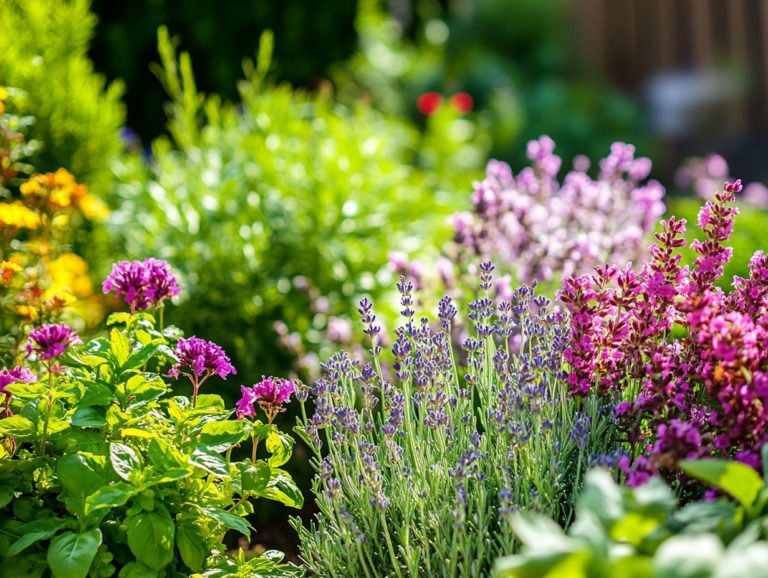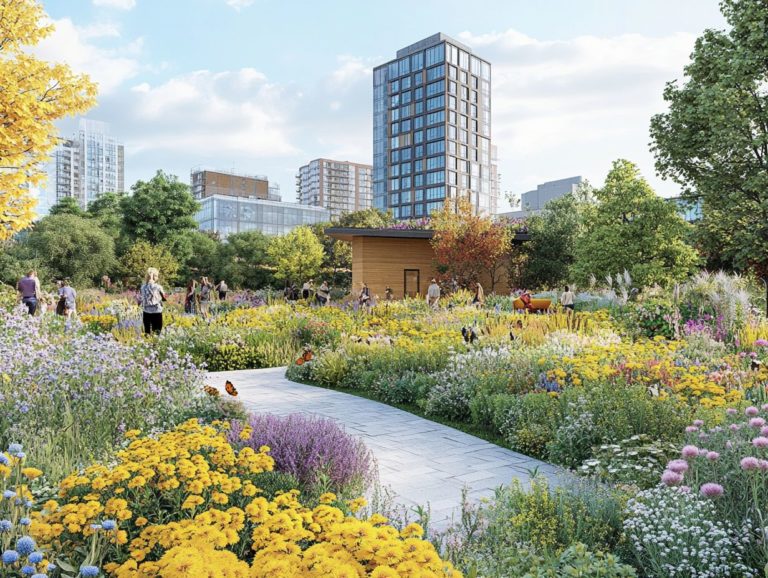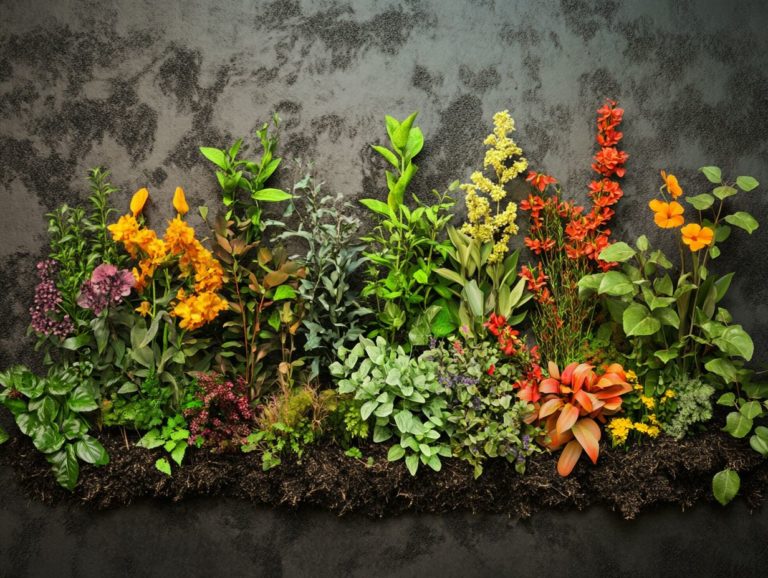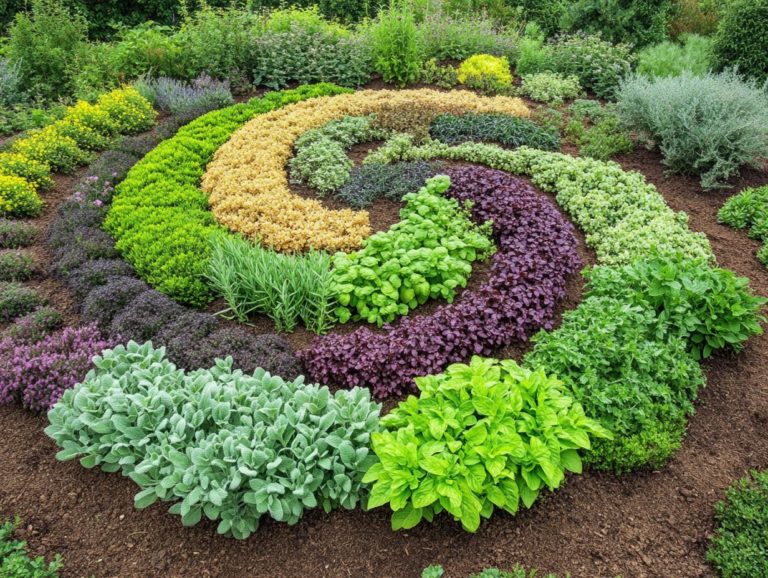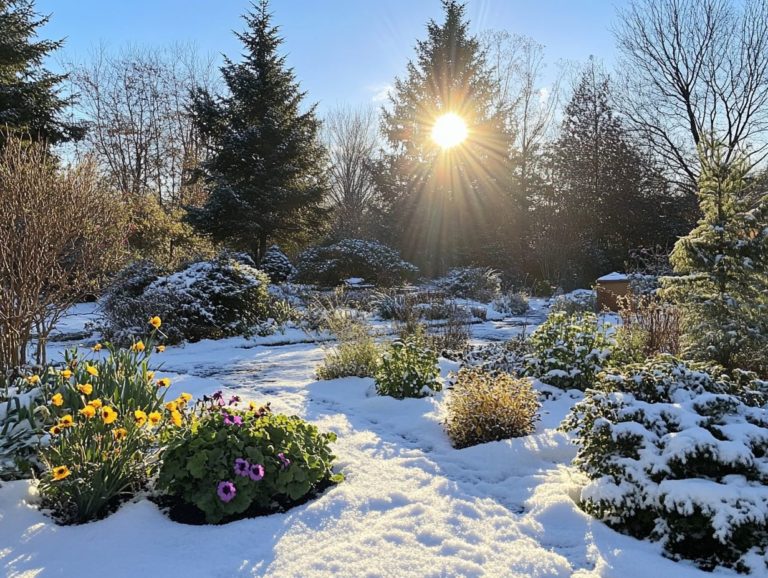“Top 5 Ground Covers for Erosion Control”
Erosion poses a serious threat to our landscapes and ecosystems. Understanding its causes and finding effective solutions is essential for maintaining soil health.
Let s dive into the best ground covers designed to combat erosion! We will highlight key factors to consider when choosing the right plants.
From native grasses to creeping juniper, explore top options and learn how to plant and maintain them for lasting benefits.
Contents
- Key Takeaways:
- 1. Understanding Erosion and Its Causes
- 2. Factors to Consider When Choosing Ground Covers for Erosion Control
- 3. Native Grasses
- 4. Creeping Juniper
- 5. Pachysandra
- 6. Vinca Minor
- 7. English Ivy
- 8. Periwinkle
- 9. Creeping Phlox
- 10. Crown Vetch
- 11. Sweet Woodruff
- 12. Alternatives to Traditional Ground Covers
- 13. How to Properly Plant and Maintain Ground Covers for Erosion Control
- 14. Common Mistakes to Avoid When Using Ground Covers for Erosion Control
- Frequently Asked Questions
- What are the top 5 ground covers for erosion control?
- Which grasses are best for erosion control?
- What types of shrubs are recommended for erosion control?
- Are there any trees that are particularly effective at controlling erosion?
- Why are ground covers beneficial for erosion control?
- How Does Mulch Help with Erosion Control?
Key Takeaways:
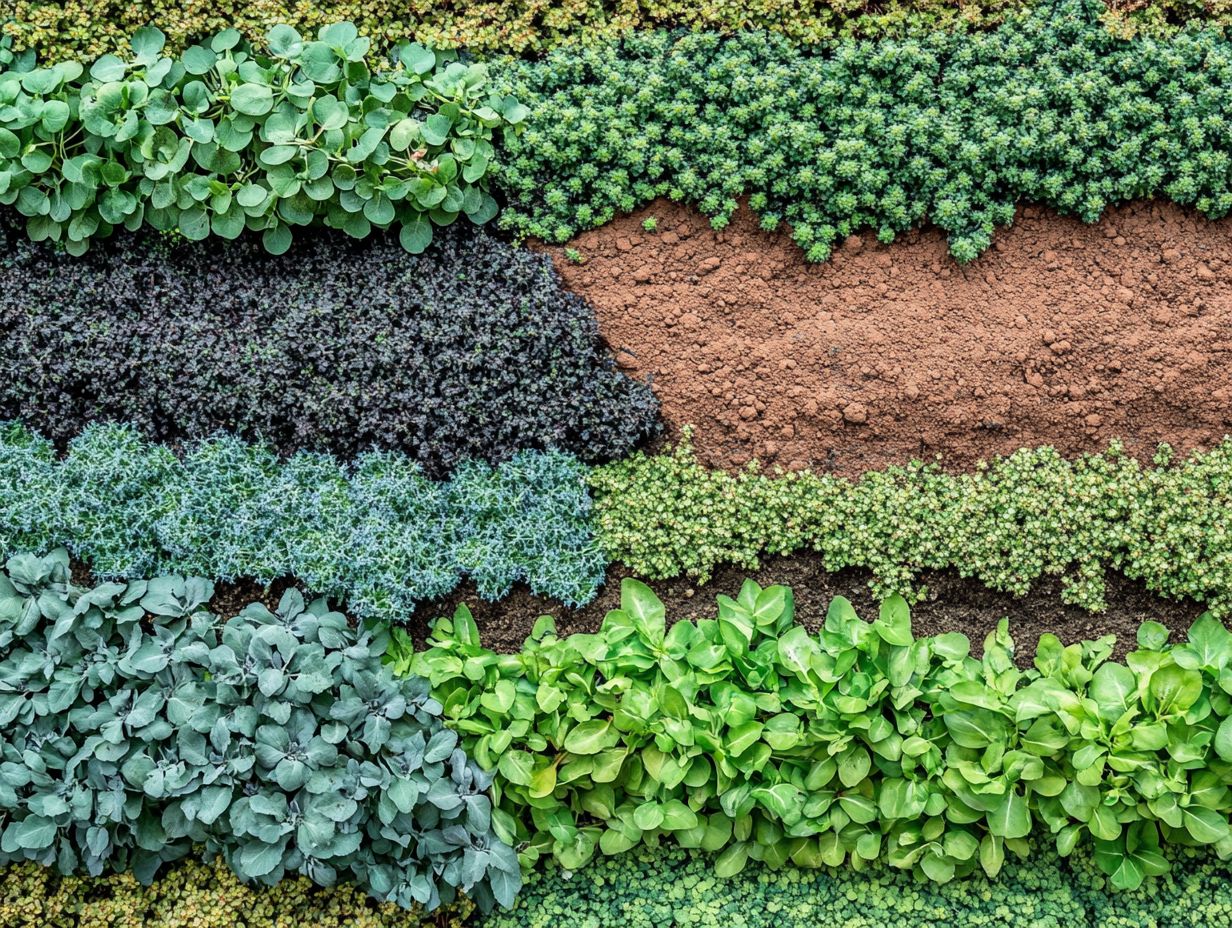
- Understanding erosion causes helps you select the right ground covers.
- Consider climate, soil type, and slope when choosing plants.
- Top choices include native grasses, creeping juniper, pachysandra, vinca minor, and English ivy.
1. Understanding Erosion and Its Causes
Erosion is a natural process that can greatly change landscapes. When soil erosion happens, it strips away the top layer, causing challenges for hillside stabilization and affecting both vegetation and ecosystems.
Recognizing causes like water runoff, wind, and human activities is vital. By understanding these factors, you can implement effective ways to prevent erosion.
Your actions such as deforestation and urbanization can worsen soil erosion. Heavy rainfall increases water runoff, while strong winds can displace soil particles.
Keeping soil moist helps bind particles together, enhancing soil stability. Incorporating native plants supports local biodiversity and strengthens soil with their extensive root systems!
2. Factors to Consider When Choosing Ground Covers for Erosion Control
Selecting ground covers requires attention to several key factors. Look for plants with dense foliage that can endure dry spells and require low maintenance.
It s crucial to consider how well these plants adapt to various soil types and light conditions. A successful establishment is necessary for creating a thriving environment to stabilize the soil.
Dense foliage helps anchor the earth and enhances your landscape, attracting wildlife and adding beauty!
3. Native Grasses
Native grasses are vital for your erosion control toolkit. Their strong root systems improve soil stability and contribute to the ecosystem’s health.
These grasses thrive in local environments, showing resilience against drought and various soil conditions. They create a dense root network that anchors the soil and enhances water infiltration.
Native grasses also provide habitats for beneficial wildlife, attracting pollinators and enriching biodiversity. Varieties like Big Bluestem, Switchgrass, and Little Bluestem excel in stabilizing soil with both environmental and ecological benefits.
4. Creeping Juniper
Creeping Juniper stands out as an exceptional choice for ground cover when it comes to erosion control, thanks to its low-maintenance nature and adaptability to various soil types. This makes it perfectly suited for landscaping in areas prone to erosion.
Imagine a hardy evergreen that sprawls impressively, reaching widths of up to six feet while maintaining a modest height of only a foot. This growth habit allows it to effortlessly blend into a diverse garden aesthetic. Its outstanding drought tolerance renders it a sustainable choice for landscaping that saves water, ensuring that your landscapes thrive even in challenging climates.
The dense foliage of Creeping Juniper plays a crucial role in stabilizing soil, curbing erosion on slopes, and promoting efficient drainage.
It’s not just functionality that sets this plant apart. Its blue-green needles add texture and color, enhancing the visual appeal of your garden and beautifully complementing other plant varieties across a range of landscapes.
5. Pachysandra
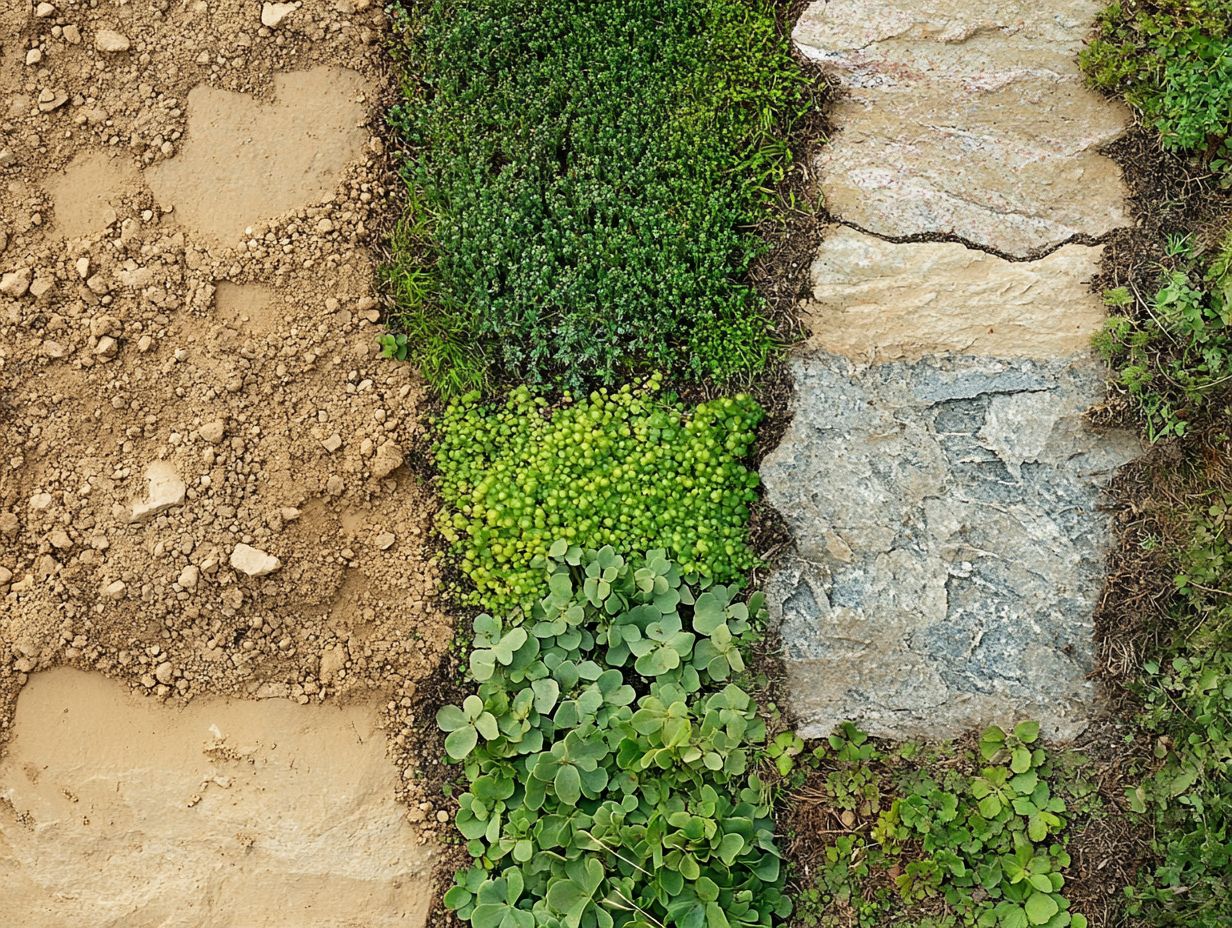
Pachysandra is an exceptional ground cover that stands out for its dense foliage and remarkable ability to thrive in shady environments. This makes it a prime choice for erosion control in various landscaping scenarios.
Not only does this hardy plant enhance the beauty of your space with its lush greenery, but it also plays a vital role in stabilizing soil, preventing water runoff, and fostering a healthier microclimate.
For optimal growth, Pachysandra flourishes in well-drained, moist soil and prefers partial to full shade, making it ideal for planting under trees or in cozy, shaded garden beds.
To ensure it performs at its best, regular maintenance is key. Occasional pruning encourages new growth, while clearing away debris can prevent plant disease from taking root. Adding a layer of mulch (a protective covering for soil) helps retain soil moisture and suppress weeds, allowing this resilient ground cover to reach its full potential while elevating the overall landscape.
6. Vinca Minor
Vinca Minor, commonly known as periwinkle, is a robust ground cover that not only excels in erosion control but also showcases charming flowering perennials, elevating any garden design to the next level.
This resilient plant flourishes in a variety of conditions, making it a versatile choice for both shaded and sunny spots in your garden. With its glossy green leaves and delicate purple or white flowers that bloom in spring, it infuses your outdoor space with vibrant color throughout the growing season.
Gardeners love Vinca Minor for its effortless charm and vibrant blooms! It matures quickly and fills in gaps beautifully, making it an ideal option for borders, rock gardens, and slopes. Its dense matting not only suppresses weeds but also stabilizes the soil, fostering a healthier ecosystem in your landscaped areas.
7. English Ivy
English Ivy stands out as a premium ground cover that excels in erosion control, thanks to its rapid growth and minimal maintenance requirements. This makes it an attractive choice for any homeowner aiming to stabilize soil effectively.
Thriving in a range of environmental conditions from sunlit areas to shaded nooks this resilient plant offers remarkable versatility for various landscapes. Its dense foliage not only anchors the soil but also diminishes surface runoff, playing a vital role in preventing erosion during heavy rains.
With its ability to spread swiftly across uneven terrain, English Ivy adapts and flourishes where other plants may falter. When managed properly through periodic trimming and maintenance, it serves as an efficient solution for controlling erosion while adding a vibrant, green aesthetic to any property.
8. Periwinkle
Periwinkle, commonly known as Vinca minor, is a delightful ground cover that not only stabilizes soil in areas prone to erosion but also infuses your landscape with vibrant color through its enchanting flowering perennials.
This resilient plant flourishes in a variety of conditions, making it an excellent choice for enhancing your outdoor spaces. The glossy green foliage serves as a stunning backdrop for its captivating purple flowers, which bloom from spring to fall. This ensures your garden remains visually appealing throughout the seasons.
Beyond its aesthetic charm, this ground cover effectively combats soil erosion, forming a dense mat that secures the soil in place. For optimal growth, plant it in well-drained soil and provide it with partial to full shade. Remember to keep it well-watered, especially during dry spells. A bit of light pruning now and then will help maintain its shape while promoting even more vigorous flowering.
9. Creeping Phlox
Creeping Phlox is an exceptional choice for ground cover that masterfully blends beauty and functionality. It offers stunning flowers while effectively controlling erosion on slopes and in your gardens.
This remarkable plant showcases vibrant blossoms that range from pink to purple, creating a captivating display in early spring. Its beautiful flowers not only enliven your landscape but also attract pollinators, contributing to a thriving ecosystem.
Versatile enough for various soil types, including sandy and loamy conditions, it flourishes in both sunny and partially shaded areas. By forming a dense mat of foliage and root systems, this plant does a fantastic job of stopping soil erosion while enhancing the visual appeal of pathways and borders with different types of plants.
10. Crown Vetch
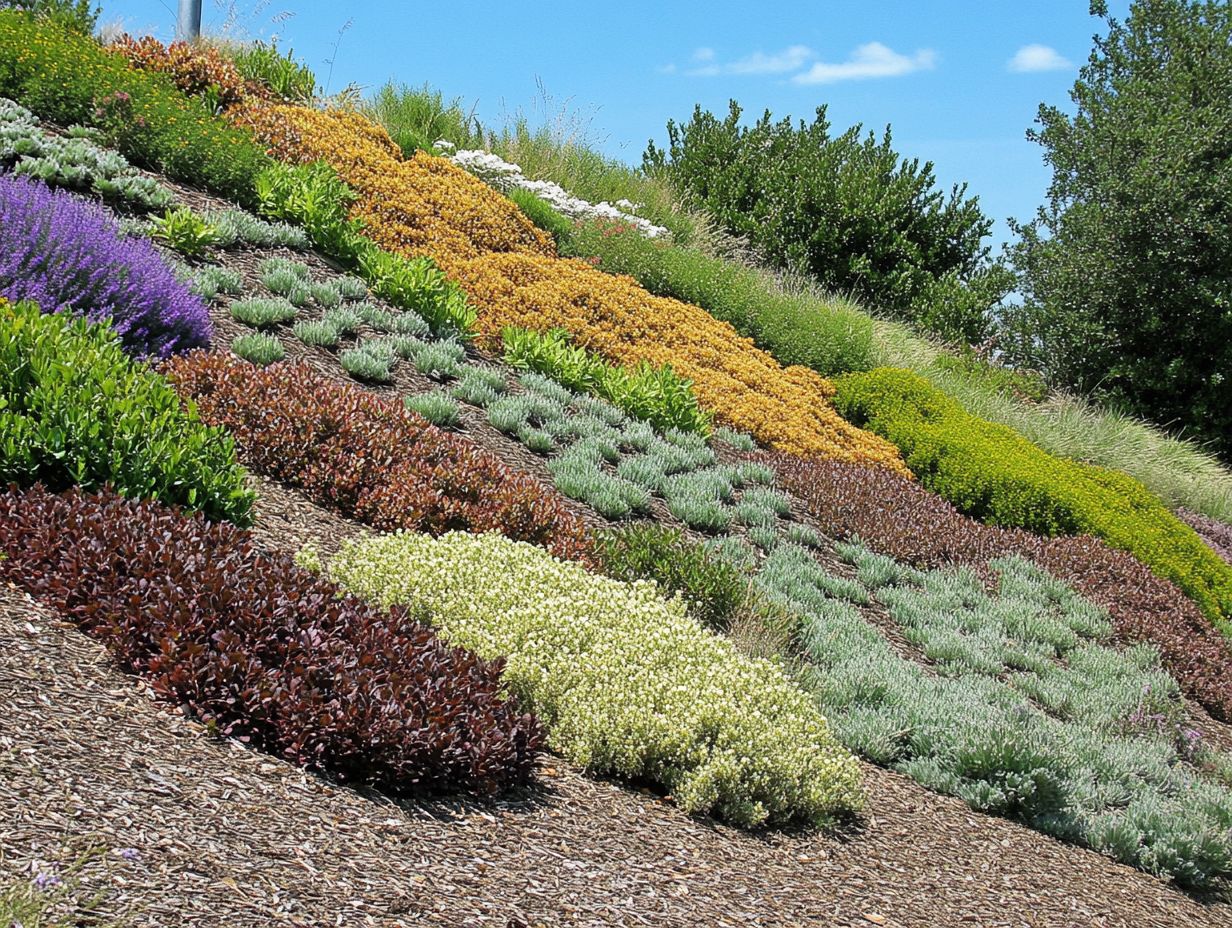
Crown Vetch stands out as a robust ground cover, celebrated for its remarkable soil stabilization abilities and how it keeps the soil moist, especially in drought-prone areas. It’s an excellent choice for erosion control, particularly in challenging landscapes.
This perennial grows well in many conditions, from dry, well-drained soils to poorer soil types where many plants find it hard to survive. Its trailing growth habit enables it to spread rapidly, forming a dense mat that prevents soil loss and enriches the soil naturally. Look for its pretty clusters of pink to purple flowers! You’ll love how it brightens up your garden while attracting a variety of pollinators.
These features make Crown Vetch a favored choice for both agricultural and ornamental applications, as it combines usefulness with beauty.
11. Sweet Woodruff
Sweet Woodruff is a charming ground cover that you ll appreciate for its fragrant foliage and low-maintenance qualities, ideal for busy gardeners. It’s an excellent choice for erosion control in shaded areas.
This perennial flourishes in well-drained, moist soil and thrives in partial to full shade, creating a lush carpet that enhances your garden’s visual appeal while stabilizing the soil. By forming a dense mat, this versatile plant effectively prevents soil erosion in erosion-prone areas, especially on slopes and less stable terrains.
Its ability to retain moisture in the soil ensures that neighboring plants receive the hydration they need, making it an ideal companion for your garden’s aesthetics. With its delicate white flowers, Sweet Woodruff adds seasonal charm, attracting pollinators and contributing to a harmonious, eco-friendly landscape.
12. Alternatives to Traditional Ground Covers
Exploring alternatives to traditional ground covers opens up a world of innovative landscaping solutions for steep slopes. These solutions effectively combat soil erosion and enhance ecological diversity.
By turning to native plants like Aronia and Juniper, you can find resilient options. These plants not only anchor the soil but also promote a balanced ecosystem.
They adapt beautifully to local conditions, often needing less maintenance and irrigation than conventional ground covers. Their deep root systems significantly improve moisture retention.
This allows the soil to withstand both drought and heavy rainfall. Beyond practical benefits, using native species attracts pollinators and supports local wildlife.
This enriches the overall health of the environment and creates a vibrant landscape that thrives harmoniously with nature.
13. How to Properly Plant and Maintain Ground Covers for Erosion Control
Proper planting and maintenance of ground covers are essential for effective erosion control. These practices ensure that your selected plants thrive and play a vital role in soil stabilization over time.
Consider factors like spacing when placing the plants. Maintaining adequate distance promotes healthy growth and minimizes competition for resources.
Soil preparation is equally important. Test for nutrients and adjust pH levels to create optimal conditions for robust root development.
Consistent watering practices, especially during the establishment phase, are crucial. Regular maintenance, like mulching and timely pruning, will help sustain the health of your ground cover.
These steps enhance its effectiveness in combating soil erosion and elevate the visual appeal of your landscape.
14. Common Mistakes to Avoid When Using Ground Covers for Erosion Control
Ground covers can effectively control erosion, but common mistakes can hinder success. Avoiding these pitfalls is crucial for effective soil stabilization.
Often, missteps arise from selecting plant species that aren t well-suited for specific site conditions, such as poor soil quality or inadequate sunlight. Neglecting soil preparation can lead to poor root establishment, diminishing the ground cover’s effectiveness.
To steer clear of these pitfalls, carefully evaluate your site. Choose native or well-adapted plants that fit your environment.
Regular maintenance, including proper watering and timely weeding, will keep your ground cover vigorous and capable of controlling erosion.
Frequently Asked Questions

What are the top 5 ground covers for erosion control?
Top ground covers include grasses, shrubs, trees, and mulch. These help stabilize soil and prevent erosion.
Which grasses are best for erosion control?
Grasses such as fescue, bluegrass, and ryegrass have strong root systems that can help prevent erosion. They are also fast-growing and can quickly establish themselves in the soil.
What types of shrubs are recommended for erosion control?
Shrubs such as juniper, spirea, and forsythia are good options for erosion control. They have deep root systems and dense foliage that can help hold soil in place.
Are there any trees that are particularly effective at controlling erosion?
Yes, trees such as willows, poplars, and red maples are known for their ability to prevent erosion. Their deep, extensive root systems can hold soil in place and their large canopies can help absorb excess water.
Why are ground covers beneficial for erosion control?
Ground covers, such as creeping phlox, sweet woodruff, and periwinkle, help to cover and protect bare soil from erosion. They also add visual interest to the landscape and can help to improve soil health.
How Does Mulch Help with Erosion Control?
Organic mulches, like bark chips or shredded leaves, create a shield over the soil. This protective layer keeps the soil safe from erosion.
Mulch also retains moisture, preventing the soil from drying out. Keeping the soil moist is crucial for effective erosion control.

